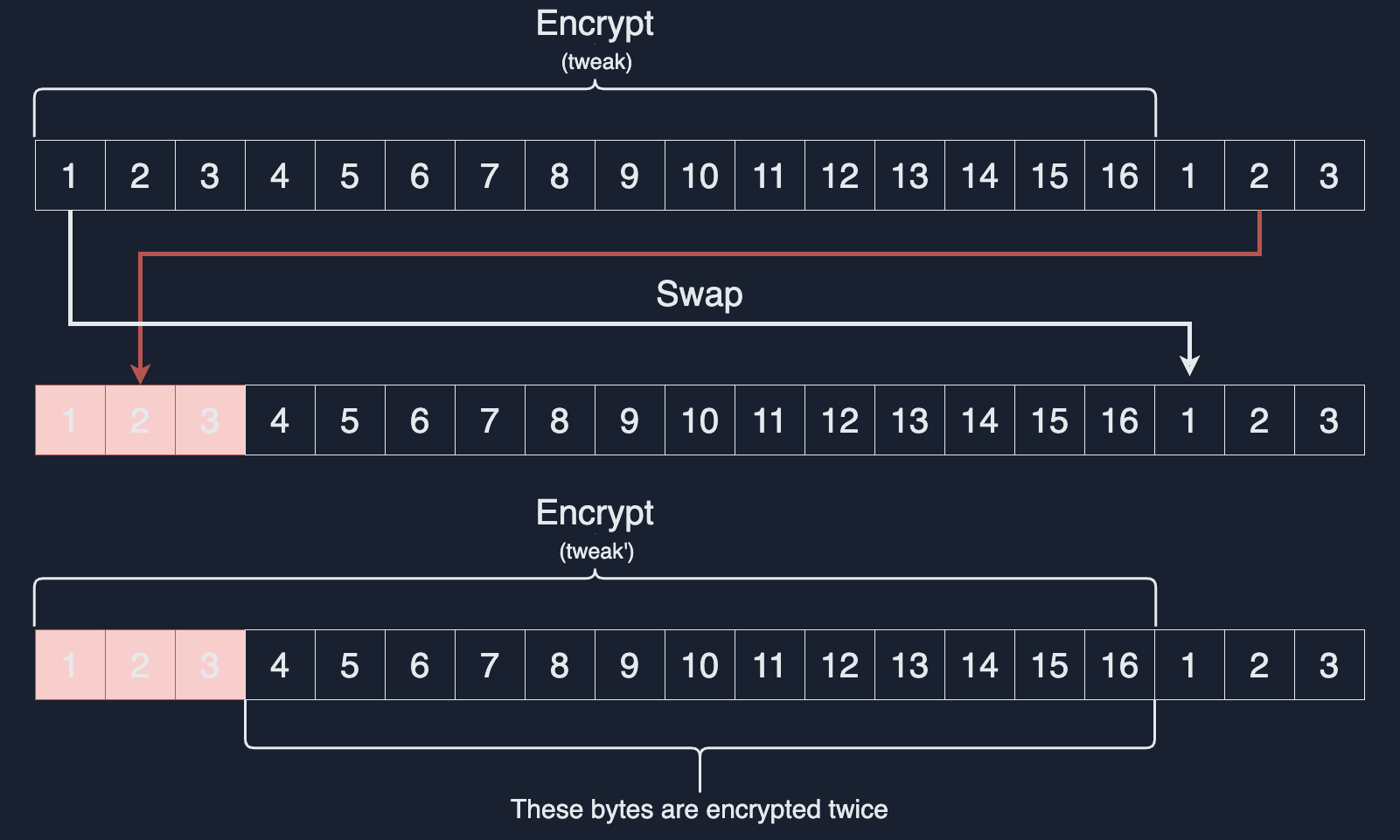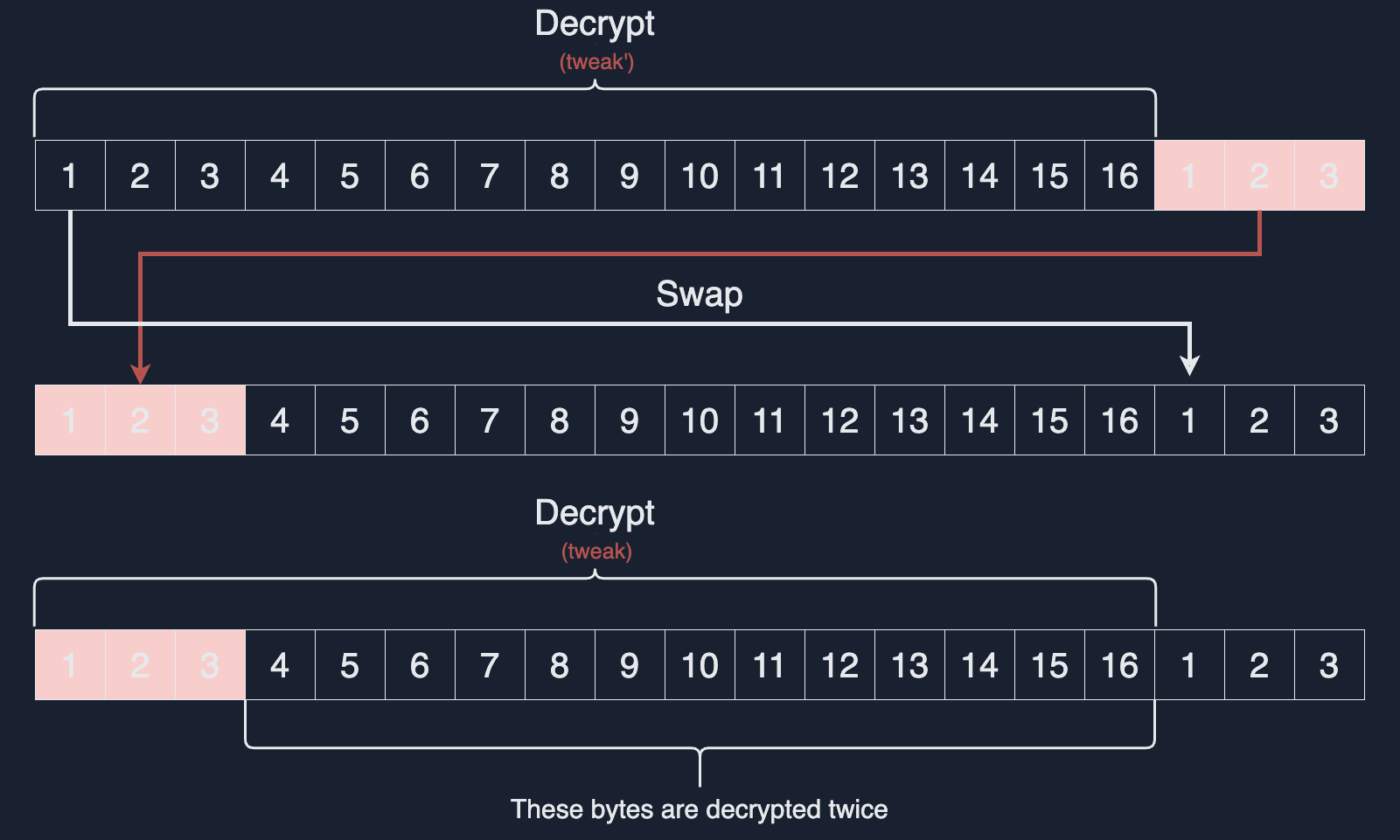Cryptography 🤝 Vectorization
Using AES-XTS as a lens into vectorization techniques.
Cryptography 🤝 Vectorization
Using AES-XTS as a lens into
Agenda
- What is AES and how does it work?
- What is XTS and how does it work?
- Vectorization 101
- Vectorization in the real world
- Bonus optimizations
AES
AES is the Advanced Encryption Standard, defined in FIPS 197 published in 2001.
- It is a symmetric key block cipher algorithm that works on 16-byte blocks.
- It’s the underlying encryption used in technologies like SSL/TLS.
AES
AES comes in different flavors whose distinction is the size of the key: 128, 192, or 256 bits.
Before [[en|de]]cryption, keys are expanded into “round keys”, leaving the only difference between AES-[[128|192|256]] to be the number of rounds:
- 128 bits has 10 rounds
- 192 bits has 12 rounds
- 256 bits has 14 rounds
AES
What is meant by “round”?
Each round has 4 transformations: SubBytes, ShiftRows,
MixColumns, and AddRoundKey. The algorithm runs each of these
transformations on the 16-byte state block for \(n\) rounds.
round :: [Word32] -> [Word32] -> [Word32]
round rk = addRoundKey rk . mixColumns . shiftRows . subBytes
roundLast :: [Word32] -> [Word32] -> [Word32]
roundLast rk = addRoundKey rk . shiftRows . subBytes
encrypt_ :: [Word32] -> [Word32] -> [Word32]
encrypt_ plain expandedKey =
go (addRoundKey (take 4 expandedKey)
(matrify plain)) (drop 4 expandedKey) 1
where
go :: [Word32] -> [Word32] -> Int -> [Word32]
go state ek 14 = matrify $ roundLast ek state
go state ek i = go (round (take 4 ek) state) (drop 4 ek) (i + 1)AES
What is meant by “round”?
Intel VAES-NI implements a single round with vaes[enc|dec]:
vpxor ($key2), $state, $state
vaesenc 0x10($key2), $state, $state
vaesenc 0x20($key2), $state, $state
vaesenc 0x30($key2), $state, $state
vaesenc 0x40($key2), $state, $state
vaesenc 0x50($key2), $state, $state
vaesenc 0x60($key2), $state, $state
vaesenc 0x70($key2), $state, $state
vaesenc 0x80($key2), $state, $state
vaesenc 0x90($key2), $state, $state
vaesenc 0xa0($key2), $state, $state
vaesenc 0xb0($key2), $state, $state
vaesenc 0xc0($key2), $state, $state
vaesenc 0xd0($key2), $state, $state
vaesenclast 0xe0($key2), $state, $stateXTS
XOR-Encrypt-XOR with Cipher Stealing (XTS) is defined in IEEE 1619, and is a confidentiality only AES mode of operation.
It is the standard encryption used for data at rest.
XTS
XTS sits on top of AES to chain together many 16-byte blocks. In its
simplest form, it is literally XOR, AESEncrypt, XOR:
XTS
XTS sits on top of AES to chain together many 16-byte blocks. In its
simplest form, it is literally XOR, AESEncrypt, XOR:
vpxor $tw, $state, $state
vpxor ($key2), $state, $state
vaesenc 0x10($key2), $state, $state
vaesenc 0x20($key2), $state, $state
vaesenc 0x30($key2), $state, $state
vaesenc 0x40($key2), $state, $state
vaesenc 0x50($key2), $state, $state
vaesenc 0x60($key2), $state, $state
vaesenc 0x70($key2), $state, $state
vaesenc 0x80($key2), $state, $state
vaesenc 0x90($key2), $state, $state
vaesenc 0xa0($key2), $state, $state
vaesenc 0xb0($key2), $state, $state
vaesenc 0xc0($key2), $state, $state
vaesenc 0xd0($key2), $state, $state
vaesenclast 0xe0($key2), $state, $state
vpxor $tw, $state, $stateXTS
XTS’s initialization vector (IV) is also called a tweak. Between each block’s encryption or decryption, it gets updated.
\[ T' = \begin{cases} (T \ll 1) \oplus \texttt{0x87} & T \gg 127 = 1 \\ T \ll 1 & \text{otherwise} \end{cases} \]
XTS
When the input length is not a multiple of 16, cipher stealing is used.

XTS
When the input length is not a multiple of 16, cipher stealing is used.

Recap
- AES is a baseline encryption tool, which encrypts (or decrypts) 16-byte blocks at a time.
- XTS is a mode of operation, a way of building upon AES’s block cipher for many blocks.
- XTS encrypts but does not authenticate and is the standard algorithm used for disk encryption.
Algorithmic Characteristics
- AES blocks themselves do not depend on one another in any way, they are isolated pieces of state.
- XTS blocks do not depend on the preceding or subsequent blocks of the input.
Vectorization 101
Vectorization is the idea of creating a “vector” of data from a set of scalars, and then using Same Instruction Multiple Data (SIMD) to do a computation on the elements of that vector in parallel.
- A scalar is a solitary unit of data, typically a number, say \(7\).
- While a vector is collection of scalars:
Vectorization 101
On x86_64, the %[xyz]mm registers are vector registers.
%xmmregisters can hold 128 bits.%ymmregisters can hold 256 bits.%zmmregisters can hold 512 bits.
Vectorization 101
Vectorized instructions are composed of a big pile of mnemonics.

Vectorization 101
Where %ymm0 and %ymm1 contain \(\mathbf{v}\) and \(\mathbf{w}\) respectively:
\[ \mathbf{v} = \begin{bmatrix} 1 \\ 2 \\ 3 \\ 4 \end{bmatrix} \\ \]
\[ \mathbf{w} = \begin{bmatrix} 5 \\ 6 \\ 7 \\ 8 \end{bmatrix} \\ \]
Vectorization 101
%ymm1 ends up holding:
Vectorization 101
* Data Independence
* Linearity
Vectorization in XTS
AES blocks in XTS are independent.
Vectorization in XTS
AES blocks in XTS are independent.
vbroadcasti32x4 ($key1), $t0
# ARK
vpternlogq \$0x96, $t0, $tw1, $st1
vpternlogq \$0x96, $t0, $tw2, $st2
# round 1
vbroadcasti32x4 0x10($key1), $t0
vaesenc $t0, $st1, $st1
vaesenc $t0, $st2, $st2
# round 2
vbroadcasti32x4 0x20($key1), $t0
vaesenc $t0, $st1, $st1
vaesenc $t0, $st2, $st2
# Continued for 14 rounds...
vmovdqu8 $st1,($output)
vmovdqu8 $st2,0x40($output)Vectorization in XTS
AES blocks in XTS are independent.
vbroadcasti32x4 ($key1), $t0
# ARK
vpternlogq \$0x96, $t0, $tw1, $st1
vpternlogq \$0x96, $t0, $tw2, $st2
vpternlogq \$0x96, $t0, $tw3, $st3
vpternlogq \$0x96, $t0, $tw4, $st4
# round 1
vbroadcasti32x4 0x10($key1), $t0
vaesenc $t0, $st1, $st1
vaesenc $t0, $st2, $st2
vaesenc $t0, $st3, $st3
vaesenc $t0, $st4, $st4
# round 2
vbroadcasti32x4 0x20($key1), $t0
vaesenc $t0, $st1, $st1
vaesenc $t0, $st2, $st2
vaesenc $t0, $st3, $st3
vaesenc $t0, $st4, $st4
# Continued for 14 rounds...
vmovdqu8 $st1,($output)
vmovdqu8 $st2,0x40($output)
vmovdqu8 $st3,0x80($output)
vmovdqu8 $st4,0xc0($output)Vectorization in XTS
Tweak generation in XTS does have “some” linearity.
If:
\[ T' = \begin{cases} (T \ll 1) \oplus \texttt{0x87} & T \gg 127 = 1 \\ T \ll 1 & \text{otherwise} \end{cases} \]
Then:
\[ T'' = \begin{cases} (T \ll 2) \oplus \texttt{0x87} & T \gg 126 = 1 \\ T \ll 2 & \text{otherwise} \end{cases} \]
Vectorization in XTS
Tweak generation in XTS does have “some” linearity.
Bonus Optimizations
Bonus Optimizations
Instruction-Level Parallelization
Bonus Optimizations
Why four?
\[ \text{Parallelism} = \text{Cycle Latency} \times \text{IPC} \]

\[ 8 = 4 \times 2 \]
Bonus Optimizations
Why four?

Bonus Optimizations
Instruction-Level Parallelization
# round 3
vbroadcasti32x4 0x30($key1), $t0
vaesenc $t0, $st1, $st1
vaesenc $t0, $st2, $st2
vaesenc $t0, $st3, $st3
vaesenc $t0, $st4, $st4
# Generate next 4 tweaks
vpsrldq \$0xf, $t0, %zmm13
vpclmulqdq \$0x0,$ZPOLY, %zmm13, %zmm14
vpslldq \$0x1, $t0, %zmm16
vpxord %zmm14, %zmm16, %zmm16
# round 4
vbroadcasti32x4 0x40($key1), $t0
vaesenc $t0, $st1, $st1
vaesenc $t0, $st2, $st2
vaesenc $t0, $st3, $st3
vaesenc $t0, $st4, $st4Bonus Optimizations
Instruction-Level Parallelization
# Tweaks 0-3
vpsllvq const_dq3210(%rip),%zmm0,%zmm4
vpsrlvq const_dq5678(%rip),%zmm1,%zmm2
vpclmulqdq \$0x0,$ZPOLY,%zmm2,%zmm3
vpxorq %zmm2,%zmm4,%zmm4{%k2}
vpxord %zmm4,%zmm3,%zmm9
# Tweaks 4-7
vpsllvq const_dq7654(%rip),%zmm0,%zmm5
vpsrlvq const_dq1234(%rip),%zmm1,%zmm6
vpclmulqdq \$0x0,$ZPOLY,%zmm6,%zmm7
vpxorq %zmm6,%zmm5,%zmm5{%k2}
vpxord %zmm5,%zmm7,%zmm10References
- crypto-ref: reference implementations of AES and XTS. This is where the Haskell code samples in this presentation come from.
- AWS-LC: the optimized AES-XTS implementation referenced in this presentation.
- FIPS 197: the standard defining AES.
- IEEE 1619: the standard defining XTS mode.
- Notes on vectorized XTS: this includes the expanded vectorized tweak generation discussed in this presentation, with comments added line-by-line explaining each step.